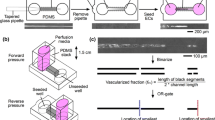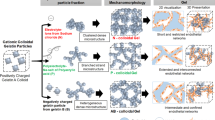Abstract
Improving our ability to control capillary morphogenesis has implications for not only better understanding of basic biology, but also for applications in tissue engineering and in vitro testing. Numerous biomaterials have been investigated as cellular supports for these applications and the biophysical environment biomaterials provide to cells has been increasingly recognized as an important factor in directing cell function. Here, the ability of ionic self-assembling peptide gels to support capillary morphogenesis and the effect of their mechanical properties is investigated. When placed in a physiological salt solution, these oligopeptides spontaneously self-assemble into gels with an extracellular matrix (ECM)-like microarchitecture. To evaluate the ability of three-dimensional (3D) self-assembled peptide gels to support capillary-like network formation, human umbilical vein endothelial cells (HUVECs) were embedded within RAD16-I ((RADA)4) or RAD16-II ((RARADADA)2) peptide gels with various stiffness values. As peptide stiffness is decreased cells show increased elongation and are increasingly able to contract gels. The observation that capillary morphogenesis is favored in more malleable substrates is consistent with previous reports using natural biomaterials. The structural properties of peptide gels and their ability to support capillary morphogenesis in vitro make them promising biomaterials to investigate for numerous biomedical applications.







Similar content being viewed by others
References
Carmeliet, P. (2005). Angiogenesis in life, disease and medicine. Nature, 438, 932–936.
Griffith, L. G., & Naughton, G. (2002). Tissue engineering–current challenges and expanding opportunities. Science, 295, 1009–1014.
Nave, B. T., Becker, M., Roenicke, V., & Henkel, T. (2002). Validation of targets and drug candidates in an engineered three-dimensional cardiac tissue model. Drug Discovery Today, 7, 419–425.
Ponec, M. (2002). Skin constructs for replacement of skin tissues for in vitro testing. Advanced Drug Delivery Reviews, 54(Suppl 1), S19–S30.
Sivaraman, A., Leach, J. K., Townsend, S., Iida, T., Hogan, B. J., Stolz, D. B., Fry, R., Samson, L. D., Tannenbaum, S. R., & Griffith, L. G. (2005). A microscale in vitro physiological model of the liver: Predictive screens for drug metabolism and enzyme induction. Current Drug Metabolism, 6, 569–591.
Narmoneva, D. A., Vukmirovic, R., Davis, M. E., Kamm, R. D., & Lee, R. T. (2004). Endothelial cells promote cardiac myocyte survival and spatial reorganization: Implications for cardiac regeneration. Circulation, 110, 962–968.
Bhatia, S. N., Balis, U. J., Yarmush, M. L., & Toner, M. (1999). Effect of cell–cell interactions in preservation of cellular phenotype: Cocultivation of hepatocytes and nonparenchymal cells. Faseb Journal, 13, 1883–1900.
Kaihara, S., Kim, S., Kim, B. S., Mooney, D. J., Tanaka, K., & Vacanti, J. P. (2000). Survival and function of rat hepatocytes cocultured with nonparenchymal cells or sinusoidal endothelial cells on biodegradable polymers under flow conditions. Journal of Pediatric Surgery, 35, 1287–1290.
Madri, J. A., Pratt, B. M., & Tucker, A. M. (1988). Phenotypic modulation of endothelial cells by transforming growth factor-beta depends upon the composition and organization of the extracellular matrix. Journal of Cell Biology, 106, 1375–1384.
Satake, S., Kuzuya, M., Ramos, M. A., Kanda, S., & Iguchi, A. (1998). Angiogenic stimuli are essential for survival of vascular endothelial cells in three-dimensional collagen lattice. Biochemical and Biophysical Research Communications, 244, 642–646.
Xin, X., Yang, S., Ingle, G., Zlot, C., Rangell, L., Kowalski, J., Schwall, R., Ferrara, N., & Gerritsen, M. E. (2001). Hepatocyte growth factor enhances vascular endothelial growth factor-induced angiogenesis in vitro and in vivo. American Journal of Pathology, 158, 1111–1120.
Park, H. J., Kong, D., Iruela-Arispe, L., Begley, U., Tang, D., & Galper, J. B. (2002). 3-hydroxy-3-methylglutaryl coenzyme A reductase inhibitors interfere with angiogenesis by inhibiting the geranylgeranylation of RhoA. Circulation Research, 91, 143–150.
Davis, G. E., & Camarillo, C. W. (1996). An alpha 2 beta 1 integrin-dependent pinocytic mechanism involving intracellular vacuole formation and coalescence regulates capillary lumen and tube formation in three-dimensional collagen matrix. Experimental Cell Research, 224, 39–51.
Yang, S., Graham, J., Jeanne, W. K., Schwartz, E. A., & Gerritsen, M. E. (1999). Functional roles for PECAM-1 (CD31) and VE-Cadherin (CD144) in tube assembly and lumen formation in three-dimensional collagen gels. American Journal of Pathology, 155, 887–895.
Lafleur, M. A., Handsley, M. M., Knauper, V., Murphy, G., & Edwards, D. R. (2002). Endothelial tubulogenesis within fibrin gels specifically requires the activity of membrane-type-matrix metalloproteinases (MT-MMPs). Journal of Cell Science, 115, 3427–3438.
Sieminski, A. L., Padera, R. F., Blunk, T., & Gooch, K. J. (2002). Systemic delivery of hGH using genetically modified tissue-engineered microvascular networks: Prolonged delivery and endothelial survival with inclusion of non-endothelial cells. Tissue Engineering, 8, 1057–1069.
Sieminski, A. L., Hebbel, R. P., & Gooch, K. J. (2004). The relative magnitudes of endothelial force generation and matrix stiffness modulate capillary morphogenesis in vitro. Experimental Cell Research, 297, 574–584.
Korff, T., & Augustin, H. G. (1999). Tensional forces in fibrillar extracellular matrices control directional capillary sprouting. Journal of Cell Science, 112, 3249–3258.
Urech, L., Bittermann, A. G., Hubbell, J. A., & Hall, H. (2005). Mechanical properties, proteolytic degradability and biological modifications affect angiogenic process extension into native and modified fibrin matrices in vitro. Biomaterials, 26, 1369–1379.
Engler, A., Bacakova, L., Newman, C., Hategan, A., Griffin, M., & Discher, D. (2004). Substrate compliance versus ligand density in cell on gel responses. Biophysical Journal, 86, 617–628.
Nehls, V., & Herrmann, R. (1996). The configuration of fibrin clots determines capillary morphogenesis and endothelial cell migration. Microvascular Research, 51, 347–364.
Kanzawa, S., Endo, H., & Shioya, N. (1993). Improved in vitro angiogenesis model by collagen density reduction and the use of type III collagen. Annals of Plastic Surgery, 30, 244–251.
Holmes, T. C. (2002). Novel peptide-based biomaterial scaffolds for tissue engineering. Trends in Biotechnology, 20, 16–21.
Zhang, S., Holmes, T., Lockshin, C., & Rich, A. (1993). Spontaneous assembly of a self-complementary oligopeptide to form a stable macroscopic membrane. Proceedings of the National Academy of Sciences of the USA, 90, 3334–3338.
Zhang, S., Holmes, T. C., DiPersio, C. M., Hynes, R. O., Su, X., & Rich, A. (1995). Self-complementary oligopeptide matrices support mammalian cell attachment. Biomaterials, 16, 1385–1393.
Narmoneva, D. A., Oni, O., Sieminski, A. L., Zhang, S., Gertler, J. P., Kamm, R. D., & Lee, R. T. (2005). Self-assembling short oligopeptides and the promotion of angiogenesis. Biomaterials, 26, 4837–4846.
Genove, E., Shen, C., Zhang, S., & Semino, C. E. (2005). The effect of functionalized self-assembling peptide scaffolds on human aortic endothelial cell function. Biomaterials, 26, 3341–3351.
Davis, M. E., Motion, J. P., Narmoneva, D. A., Takahashi, T., Hakuno, D., Kamm, R. D., Zhang, S., & Lee, R. T. (2005). Injectable self-assembling peptide nanofibers create intramyocardial microenvironments for endothelial cells. Circulation, 111, 442–450.
Semino, C. E., Kasahara, J., Hayashi, Y., & Zhang, S. (2004). Entrapment of migrating hippocampal neural cells in three-dimensional peptide nanofiber scaffold. Tissue Engineering, 10, 643–655.
Holder, W. D., Gruber, H. E., Roland, W. D., Moore, A. L., Culberson, C. R., Loebsack, A. B., Burg, K. J. L., & Mooney, D. J. (1997). Increased vascularization and heterogeneity of vascular structures occurring in polyglycolide matrices containing aortic endothelial cells implanted in the rat. Tissue Engineering, 3, 149–160.
Nor, J. E., Peters, M. C., Christensen, J. B., Sutorik, M. M., Linn, S., Khan, M. K., Addison, C. L., Mooney, D. J., & Polverini, P. J. (2001). Engineering and characterization of functional human microvessels in immunodeficient mice. Laboratory Investigation, 81, 453–463.
Gong, H., Ruberti, J., Overby, D., Johnson, M., & Freddo, T. F. (2002). A new view of the human trabecular meshwork using quick-freeze, deep-etch electron microscopy. Experimental Eye Research, 75, 374–358.
Leon, E. J., Verma, N., Zhang, S., Lauffenburger, D. A., & Kamm, R. D. (1998). Mechanical properties of a self-assembling oligopeptide matrix. Journal of Biomaterials Science–Polymer Edition, 9, 297–312.
Egginton, S., & Gerritsen, M. (2003). Lumen formation in vitro versus in vivo observations. Microcirculation, 10, 45–61.
Holmes, T. C., de Lacalle, S., Su, X., Liu, G., Rich, A., & Zhang, S. (2000). Extensive neurite outgrowth and active synapse formation on self-assembling peptide scaffolds. Proceedings of the National Academy of Sciences of the USA, 97, 6728–6733.
Semino, C. E., Merok, J. R., Crane, G. G., Panagiotakos, G., & Zhang, S. (2003). Functional differentiation of hepatocyte-like spheroid structures from putative liver progenitor cells in three-dimensional peptide scaffolds. Differentiation, 71, 262–270.
Sieminski, A. L., Hebbel, R. P., & Gooch, K. J. (2005). Improved microvascular network in vitro by human blood outgrowth endothelial cells relative to vessel-derived endothelial cells. Tissue Engineering, 11, 1332–1345.
Opas, M., & Dziak, E. (1994). bFGF-induced transdifferentiation of RPE to neuronal progenitors is regulated by the mechanical properties of the substratum. Developmental Biology, 161, 440–454.
Engler, A. J., Griffin, M. A., Sen, S., Bonnemann, C. G., Sweeney, H. L., & Discher, D. E. (2004). Myotubes differentiate optimally on substrates with tissue-like stiffness: Pathological implications for soft or stiff microenvironments. Journal of Cell Biology, 166, 877–887.
Kamei, M., Saunders, W. B., Bayless, K. J., Dye, L., Davis, G. E., & Weinstein, B. M. (2006). Endothelial tubes assemble from intracellular vacuoles in vivo. Nature, 442, 453–456.
Bayless, K. J., Salazar, R., & Davis, G. E. (2000). RGD-dependent vacuolation and lumen formation observed during endothelial cell morphogenesis in three-dimensional fibrin matrices involves the alpha(v)beta(3) and alpha(5)beta(1) integrins. American Journal of Pathology, 156, 1673–1683.
Roeder, B. A., Kokini, K., Sturgis, J. E., Robinson, J. P., & Voytik-Harbin, S. L. (2002). Tensile mechanical properties of three-dimensional type I collagen extracellular matrices with varied microstructure. Journal of Biomechanical Engineering, 124, 214–222.
Ozerdem, B., & Tozeren, A. (1995). Physical response of collagen gels to tensile strain. Journal of Biomechanical Engineering, 117, 397–401.
Park, J., Kahng, B., Kamm, R. D., & Hwang, W. (2006). Atomistic simulation approach to a continuum description of self-assembled beta-sheet filaments. Biophysical Journal, 90, 2510–2524.
Gibson, L. J., & Ashby, M. (1997). Cellular solids: Structure and properties. Cambridge: Cambridge University Press.
Knapp, D. M., Tower, T. T., Tranquillo, R. T., & Barocas, V. H. (1999). Estimation of cell traction and migration in an isometric cell traction assay. AIChE Journal, 45, 2628–2640.
Ingber, D. E., & Folkman, J. (1989). Mechanochemical switching between growth and differentiation during fibroblast growth factor-stimulated angiogenesis in vitro: Role of extracellular matrix. Journal of Cell Biology, 109, 317–330.
Gobin, A. S., & West, J. L. (2002). Cell migration through defined, synthetic ECM analogs. Faseb Journal, 16, 751–753.
Pratt, A. B., Weber, F. E., Schmoekel, H. G., Muller, R., & Hubbell, J. A. (2004). Synthetic extracellular matrices for in situ tissue engineering. Biotechnology and Bioengineering, 86, 27–36.
Zhang, S., Lockshin, C., Cook, R., & Rich, A. (1994). Unusually stable beta-sheet formation in an ionic self-complementary oligopeptide. Biopolymers, 34, 663–672.
Acknowledgements
The authors thank the generosity of Gareth McKinley for use of his rheometer, 3DM for the generous gift of RAD16-I (BD PuraMatrix), and Keith Gooch, Lisa Spirio, and Carlos Semino for insightful discussions. The authors also gratefully acknowledge funding from the National Institutes of Health (#R01-EB003805 to RDK and Ruth L. Kirschstein National Research Service Award to ALS), Draper Laboratory University IR&D Grant DL-H-550151, and the National Science Foundation Major Research Instrumentation Program (#BES-0619373 to ALS).
Author information
Authors and Affiliations
Corresponding author
Rights and permissions
About this article
Cite this article
Sieminski, A.L., Was, A.S., Kim, G. et al. The Stiffness of Three-dimensional Ionic Self-assembling Peptide Gels Affects the Extent of Capillary-like Network Formation. Cell Biochem Biophys 49, 73–83 (2007). https://doi.org/10.1007/s12013-007-0046-1
Received:
Revised:
Accepted:
Published:
Issue Date:
DOI: https://doi.org/10.1007/s12013-007-0046-1




